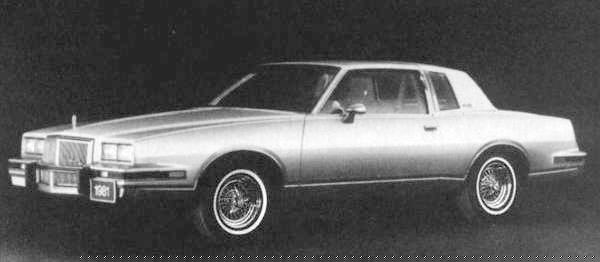
A new model for '81, the Grand Prix Brougham. |
1981
With sales in a downward spiral, Pontiac decided to give the 1981 Grand Prix all-new sheetmetal for a cleaner, more aerodynamic look. Designers raised the rear deck, while lowering the nose a like amount, forming a sleek wedge shape. The bumpers were now urethane with a bright-metal lower section.
The overall styling was striking—a dramatic change that eliminated the boxy look. Aerodynamic drag was reduced by a whopping 20 percent, and the slippery new GP instantly became a favorite among NASCAR racers.
The Grand Prix was available in three versions again, but not quite the same three as before. The base GP and the LJ returned, but the SJ was gone. In its place was the Grand Prix Brougham, an even more hedonistic vehicle than the LJ, which had a 60/40-split loose-pillow bench seat with nylon upholstery. When the GP Brougham was ordered, the buyer also got power windows, added sound deadener, padded landau top and the all-important opera lamps.
With an "economy model" and two luxo versions, the performance aspect of the Grand Prix heritage was, for the most part, forgotten.
Powerplant choices for the 1981 GP were again revised. The 301 was deleted from the lineup, although it was available in other Pontiacs. The 231 Buick V6 returned, as did the 265 Pontiac.
A third engine was made optional for the GP. It was, without a doubt, the most hideous powerplant ever to be bolted to a Grand Prix frame—even worse than the problem-plagued 231 Buick V6. It was— yes, you guessed it—the much-maligned and never-lamented 350 Olds diesel time-bomb. Belching out 105 hp at 3200 rpm, with 205 lbs.-ft, of torque at 1600, the diesel would go down in history as the most trouble-prone engine since the copper-cooled Chevy of 1923.
1982-85
With the exception of the 1986 GP 2+2, Grand Prixs of the 1981-87 model years were almost completely identical from a cosmetic point of view. It seemed as though most development of the GP was stopped at that rime, aside from keeping up with the necessary emissions, safety and CAFE standards.
For the 1982 model year, the diesel was the only V8 available in the GP. The 265 Pontiac engine, which traced its roots all the way back to 1955, was dropped. The other two engines available were the 231 Buick V6 and the new 252-cubic-inch version.
That year would ultimately go down as the low-water mark for the GP and, at that point, Pontiac Motor Division itself was in danger of being phased out completely.
For 1983, the Grand Prix once again received a gas-burning V8, although it was a 305 4-barrel Corporate (Chevy) engine. It replaced the 252 Buick V6, which was deleted from the GP lineup.
In 1984, the LJ was renamed the LE, and a 4-speed automatic was offered with the 305. The familiar snowflake wheels were replaced with a new turbo-finned aluminum design,
For '85, the GP was almost a complete carry-over, with the exception of a revised grille bar design and deletion of the diesel Olds powerplant.
NEXT >
|
|